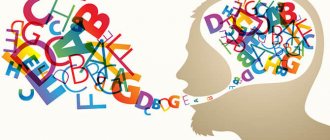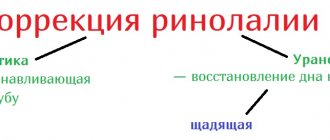Dysorthography is a child’s lack of ability to master spelling knowledge, skills and abilities related to it. This disorder is associated with insufficient development of speech functions, visual and auditory attention and perception, memory and thinking. This disorder has not been studied enough, unlike dysgraphia.
Dysgraphia is a disorder of written speech, which is caused by a disruption in the functioning of mental processes and analyzers responsible for the formation of writing skills.
Both disorders are separate conditions independent of each other. However, quite often they can occur together in one patient.
What is dysgraphia in children
Dysgraphia is caused by disturbances in the functioning of higher mental activity, when certain functions are underdeveloped, damaged or completely absent.
The disorder manifests itself in the form of systematic phonetic, grammatical and syntactic errors when writing text, while it is completely independent of the child’s literacy level and knowledge of the rules of the Russian language. Dysgraphia prevents schoolchildren from studying and mastering new material, and every test in the Russian language turns into a test. Children with such disorders begin to feel insecure, which subsequently affects their level of self-esteem and overall mental health. Dysgraphia does not go away on its own; it requires targeted correction, regular work with speech therapists, teachers, and psychologists, since it often occurs against the background of other speech disorders (alalia, dyslexia, aphasia).
Danger
Dysgraphia does not pose a health hazard, but it hinders the child’s adaptation and communication with others. The neglected form does not allow children to study in general education institutions or enter colleges and universities.
It is very important that not only parents, but also qualified speech therapists, neurologists, and teachers deal with the problem. Writing disorders cannot disappear on their own, therefore, during schooling, a child with dysgraphia should study with a speech pathologist.
Causes
Writing is a multi-level process in which several components are involved at once: visual, auditory, speech and motor systems. When interaction is disturbed, there is no coordination between systems, persistent disorders arise, characterized not only by a disorder of written, but also oral speech.
The causes of dysgraphia in primary schoolchildren and adolescents can be divided into two subgroups: organic and socio-psychological. Organic ones include:
- various brain lesions that occurred in the prenatal period or in the first months of life;
- infections suffered by the fetus during intrauterine development;
- bad habits of the mother during pregnancy (active smoking, alcoholic libations, use of illegal drugs);
- irrational or improper use of potent drugs by the mother during pregnancy;
- birth injuries resulting in mechanical damage to the brain, asphyxia;
- prematurity;
- previous infectious diseases affecting the central nervous system and brain (meningitis, encephalitis);
- severe somatic diseases with long-term treatment, resulting in nervous and physical exhaustion of the baby.
Experts point to the hereditary factor as a common cause of the development of dysgraphia in preschoolers and primary school students, as well as various diseases associated with damage to the central nervous, visual and auditory systems. Children who are prone to developing written disabilities also include children who have problems with fine motor skills.
The socio-psychological causes of dysgraphia include:
- communication within the family and in the child’s immediate environment in several languages;
- the child being left to himself, when parents and other close relatives are not involved in the general physical and mental development of the child, inattention to speech errors (pedagogical neglect);
- lack of verbal communication;
- premature or very late learning of literacy, reading, and writing skills;
- unstable psychological situation in the family (alcoholism and drug addiction of parents, frequent scandals between mom and dad, physical violence towards the child).
Speech therapists also consider one of the circumstances that can influence a child’s speech development to be the constant use of diminutive variants of words when talking to children, the deliberate softening of hard sounds, which is popularly called lisp.
Kinds
Taking into account the nature of the disorders, the following types of dysgraphia are distinguished in children and primary schoolchildren:
- agrammatic, caused by an underdeveloped lexico-grammatical level, when the child confuses cases, suffixes, genders, and incorrectly uses endings and declensions;
- articulatory-acoustic, associated with disorders of articulation, sound reproduction and auditory perception;
- acoustic, caused by incorrect recognition of phonemes by ear, when the baby confuses paired sounds and changes, for example, “Z” to “S”, “D” to “T”;
- optical, the cause of which is underdeveloped visual-spatial perception, and then the child loses part of the letter (for example, instead of “SH” he writes “I”) or adds non-existent elements to the symbols;
- dysgraphia, caused by imperfect analysis and synthesis, when children swap the endings and beginnings of words, confuse syllables, rearrange or omit letters.
In isolated form, each type of disorder is extremely rare; in most cases, schoolchildren have a mixed type of pathology, and the causes can be both organic and socio-psychological at the same time.
Clinical manifestations
Manifestations of dysgraphia depend on the type of disorder:
- with the articulatory-acoustic form of pathology, the child misses letters, misses sounds during oral speech, and replaces letters;
- acoustic dysgraphia is characterized by the substitution of letters, the replacement of stressed vowels, paired consonants - the child cannot indicate soft and hard consonants in writing;
- in the case of a disorder that has developed due to impaired ability to synthesize and analyze linguistic material , characteristic manifestations will be failure to complete words in writing, moving letters within a word, merging several words into one, adding unnecessary letters;
- with the optical form of the disorder, the child replaces some handwritten letters with others that are similar in appearance, replaces letters that have a different number of identical elements, it is also possible to write letters in a mirror projection, unfinished writing of letters;
- The agrammatic type of disorder by the following errors: violation of word structure, replacement of suffixes and prefixes, failure to comply with case endings, lack of agreement between words in a sentence, omission and replacement of prepositions, distortion of the sequence of words.
Dysorphography is manifested by the following symptoms:
- inability to remember the concepts of “word”, “sound”, “syllable”;
- difficulty in mastering spelling rules (happens more slowly than with other students);
- lack of developed skills to make inferences, determine the sequence of actions when performing written tasks in the language;
- giving incorrect examples of learned rules;
- misunderstanding of grammatical features of spellings;
- difficulties in tasks involving the selection of related words, parsing a word into its component morphemes;
- failure to complete self-test tasks.
Symptoms
The main sign of a written language disorder is typical mistakes that are repeated with every spelling, which the child makes unconsciously, even knowing the rules of the Russian language and the correct spelling of letters. The most striking signs of dysgraphia in children are:
- mixing/replacing graphically similar characters (“sh-sch”, “ml-l”, “i-sh”) or phonetically similar (“d-t”, “b-p”, “zh-sh”);
- a change in the structure of a word or sentence, when a child swaps syllables, individual letters, rearranges entire words in a phrase, adds non-existent letters and sounds to phrases or, on the contrary, loses them (“stool” - “butaret”, “boy” - “boy” , “dog” – “dog”);
- violation of the order of writing words with prepositions and prefixes, when the student incorrectly separates words or adds unnecessary symbols to them (for example, “and-dut”, “to-get”);
- inconsistency of words in a sentence when writing and speaking, for example, “big mountain”, “funny boy”, “strict teacher”.
Along with typical errors when writing, signs of dysgraphia in younger schoolchildren may include:
- slowness when writing;
- various variations in case and inclination of letters;
- line displacement, when words gradually move down or rise above the desired level, even when written using rulers;
- replacing uppercase characters with lowercase ones or vice versa;
- illegible, crooked handwriting.
Some neurological symptoms may also be observed: manifestations of attention deficit hyperactivity disorder, delayed speech development, inattention, difficulty concentrating, decreased performance, poor memorization of material aurally and visually.
As they begin school, some children suddenly develop difficulties with reading and writing. The guys find themselves at odds with the Russian language, although they do well in mathematics and other subjects where, it would seem, more intelligence is required. Sooner or later, such “smart” ones, but lacking speech talent, are sometimes referred to a speech therapist. More often to a psychologist, which is not entirely correct. Dysgraphia is a partial specific writing disorder.
There are five forms of dysgraphia:
Material from the site www.logoped.ru
1. Articulatory-acoustic form of dysgraphia. Its essence is as follows: A child who has a violation of sound pronunciation, relying on his incorrect pronunciation, records it in writing. In other words, he writes as he pronounces. This means that until the sound pronunciation is corrected, it is impossible to correct writing based on pronunciation. 2. Acoustic form of dysgraphia. This form of dysgraphia manifests itself in the substitution of letters corresponding to phonetically similar sounds. At the same time, in oral speech, sounds are pronounced correctly. In writing, letters are most often mixed, indicating voiced - unvoiced (B-P; V-F; D-T; Zh-Sh, etc.), whistling - hissing (S-Sh; Z-Zh, etc.). ), affricates and components included in their composition (CH-SH; CH-TH; C-T; C-S, etc.). It also manifests itself in the incorrect designation of the softness of consonants in writing: “pismo”, “lubit”, “hurt”, etc. 3. Dysgraphia due to a violation of language analysis and synthesis. This is the most common form of dysgraphia in children suffering from written language disorders. The following errors are most typical for it:
? omissions of letters and syllables;
rearrangement of letters and (or) syllables;
underwriting of words;
writing extra letters in a word (this happens when a child, while pronouncing while writing, “sings the sound” for a very long time;
repetition of letters and (or) syllables;
contamination - syllables of different words in one word;
? continuous writing of prepositions, separate writing of prefixes (“on the table”, “on stepped”). 4. Agrammatic dysgraphia. Associated with underdevelopment of the grammatical structure of speech. The child writes ungrammatically, i.e. as if contrary to the rules of grammar (“beautiful bag”, “happy day”). Agrammatisms in writing are noted at the level of words, phrases, sentences and text. Agrammatic dysgraphia usually manifests itself from the 3rd grade, when a student who has already mastered literacy “closely” begins to study grammatical rules. And here it suddenly turns out that he cannot master the rules of changing words according to cases, numbers, and gender. This is expressed in incorrect spelling of the endings of words, in the inability to coordinate words with each other. 5. Optical dysgraphia. Optical dysgraphia is based on insufficient development of visual-spatial concepts and visual analysis and synthesis. All letters of the Russian alphabet consist of a set of the same elements (“sticks”, “ovals”) and several “specific” elements. Identical elements are combined in different ways in space and form different letter signs: i, w, c, sch; b, c, d, y... If a child does not catch the subtle differences between letters, then this will certainly lead to difficulties in mastering the outline of letters and to incorrect representation of them in writing. Errors that are most common in writing: - underwriting of letter elements (due to underestimation of their number): L instead of M; X instead of F, etc.; — adding extra elements; - omissions of elements, especially when connecting letters that include the same element; - mirror writing of letters.
What you need to pay special attention to:
1. If your child is left-handed. 2. If he is a retrained right-hander. 3. If your child attended a speech therapy group. 4. If the family speaks two or more languages. 5. If your child went to school too early (learning to read and write unjustifiably earlier sometimes provokes the occurrence of dysgraphia and dyslexia.) This happens in cases where the child has not yet reached the psychological readiness for such learning. 6. If your child has problems with memory and attention. 7. Mixing letters by optical similarity: b-p, t-p, a-o, e-z, d-u. 8. Errors caused by impaired pronunciation, the child writes what he says: leka (river), suba (fur coat). 9. With impaired phonemic perception, the vowels o-u, e-yu, consonants r-l, y-l, paired voiced and voiceless consonants, whistling and hissing, sounds ts, ch, shch are mixed. For example: tynya (melon), klyokva (cranberry). 10. Missing letters, syllables, missing words. For example: prta - desk, moko - milk, cheerful (cheerful).
Dear readers, please note! Dysgraphia never comes out of nowhere! Work to eliminate dysgraphia should begin not at school, when specific errors in writing are discovered, but in preschool age, long before the child begins to learn to read and write. Children suffering from dysgraphia need special speech therapy help, since specific writing errors cannot be overcome by conventional school methods. It is important to consider that dysgraphia is much easier to prevent than to eliminate.
Who can teach a child to read and write?
Mom and dad are unlikely to succeed; they need the help of a specialist - a qualified speech therapist. Classes are conducted according to a specific system: various speech games, a split or magnetic alphabet for adding words, and highlighting the grammatical elements of words are used. The child must learn how certain sounds are pronounced and which letter this sound corresponds to when writing. Typically, a speech therapist resorts to contrasts, “working out” how hard pronunciation differs from soft pronunciation, and dull pronunciation from voiced pronunciation. Training is carried out by repeating words, dictation, selecting words based on given sounds, and analyzing the sound-letter composition of words. It is clear that they use visual material to help remember the shapes of letters: “O” resembles a hoop, “F” - a beetle, “C” - a crescent... Strive to increase the speed of reading and writing.
Some tips for parents:
1. If a child is assigned to read a text at home or write a lot, then break the text into parts and complete the task in several steps. 2. Do not force your child to rewrite homework many times; this will not only harm the child’s health, but also instill in him insecurity, and also increase the number of mistakes. 3. Praise your child for every success achieved, humiliate him as little as possible.
A few words about handwriting.
The handwriting of a dysgraphic person is an expression of all his difficulties. As a rule, in a dysgraphic person two types of handwriting stand out quite sharply: one is small, beady and “beautiful”; the other is huge, clumsy, clumsy, “ugly.” So, in this case there is no need to chase beauty, it will come on its own. As experience shows, clumsy and huge letters are precisely what a child should ultimately come to and work on. This handwriting is his real face, the face of an honest first-grader who wants and can learn (our first-grader, by the way, can be 10 or 16 years old, we are talking about the psychological age of learning to write).
So, DOWN with the beaded chain of letters, LONG LIVE the sweeping handwriting, for the entire line, or maybe one and a half!
HOW TO TEACH.
Everything is quite simple here. For some time (usually two to three weeks is enough for this), a paragraph of text from any work of art or an exercise from a SMALL SIZE textbook is copied EVERY DAY in a notebook. The text, which is VERY IMPORTANT, is rewritten in CELLS, ONE LETTER PER CELL, THE LETTER MUST OCCUPY THE WHOLE CELL!
Material from the site www.logoped.ru
The psychological preparation of the child for classes is also important here. In an unfavorable psychological atmosphere, classes “under pressure”, there may be no results. The volume of text, I emphasize once again, should be small; for a child under ten years old it can be only one line a day, but it should be clearly rewritten. The overall goal is to prevent the slightest disgust, fatigue, or even dissatisfaction with yourself!
There are tricks to choosing stationery for dysgraphics.
Massaging your fingertips is important for proper brain function when writing. This is what I recommend to ALL speech therapists. Therefore, it is good if the place of “grip” of a writing object (pen or pencil) is covered with ribs or pimples.
But it’s even better if the student is comfortable holding this very pen, then the handwriting is more likely to stabilize. And for this, the body must be triangular. Such pens and pencils for dysgraphics with a triple section to support three holding fingers are produced, for example, by the company /deleted by the administrator/. There are triangular pencils and felt-tip pens from the company /removed by the administrator/. Unfortunately, I have not yet seen both “conveniences” combined: the triangle and the pimples. So buy a bubble pen and a triangular pencil.
I would also like to note that stationery that has some special features will be a source of little pride for the child in front of his classmates, which can at least slightly smooth out school failures.
Girls often like to buy pens with multi-colored, shiny, etc. paste, fortunately they are allowed to write with them (in music lessons, labor lessons, etc.). So let it be better that the value of a pen in a child’s eyes be a beautiful, colored, unusually shaped body than a colored gel that makes it dazzle in the eyes and in the notebook. When buying a pen, check how it writes and whether the ink bleeds through to the other side of the page.
Gel pens are considered the most suitable for dysgraphics (pressure is felt), but in first grade they will most likely be prohibited from using them: they often leak, freeze, and spoil. Therefore, at home, it is useful for even the youngest to play a medieval scribe - to practice writing with a feather and ink (if parents do not know how, then you can ask your grandparents). “Pen” writing forms the correct position of the hand relative to the surface of the paper. At the same time, however, there is a fascinating opportunity to get smeared with ink and smear your notebook, table, nose, knees, etc., so be careful.
A FEW EXERCISES to help overcome dysgraphia
I would like to warn you that these exercises will not eliminate the problem, but will help parents in overcoming dysgraphia and will help the speech therapist work on the defect.
Exercise "Proofreading".
For this exercise you need a book, boring and with a fairly large (not small) font. The student works every day for five (no more) minutes on the following task: crosses out the given letters in a continuous text. You need to start with one letter, for example, “a”. Then “o”, then the consonants with which there are problems, first they also need to be asked one at a time. After 5-6 days of such classes, we switch to two letters, one is crossed out, the other is underlined or circled. The letters should be “paired”, “similar” in the student’s mind. For example, as practice shows, most often difficulties arise with the pairs “p/t”, “p/r”, “m/l” (spelling similarity); “y/d”, “y/y”, “d/b” (in the latter case the child forgets whether the tail of the circle is pointing up or down), etc.
The pairs required for development can be established when viewing any text written by your child. After seeing the correction, ask what letter he wanted to write here. More often than not, everything is clear without explanation.
Attention! It’s better if the text is not read (that’s why the book needs to be boring). All attention must be concentrated on finding the given shape of a letter, one or two, and work only with them.
Exercise “Writing out loud.”
An extremely important and irreplaceable technique: everything that is written is spoken out loud by the writer at the time of writing and the way it is written, with underlining and highlighting weak parts.
That is, “Another O-din h-rez-you-cha-Y-but-important reception” (after all, in fact, we say something like “LOOKING FOR AN EMERGENCY IMPORTANT PREMIERE”). The example is simpler: “ON THE TABLE WAS A JUG WITH MILK” (a jug of malak melted on the steel). By “weak beats” we mean sounds that, when pronounced in fluent speech, the speaker pays the least attention to. For vowel sounds, this is any unstressed position; for consonants, for example, a position at the end of a word, such as “zu*p”, or before a voiceless consonant, such as “lo*shka”. It is also important to clearly pronounce the end of the word, since for a dysgraphic person it is difficult to finish the word to the end, and often for this reason the habit of “putting sticks” is developed, i.e. add an indefinite number of squiggle sticks to the end of a word, which at a quick glance can be mistaken for letters. But the number of these squiggles and their quality do not correspond to the letters at the end of the word. It is important to determine whether your child has developed this habit. However, regardless of whether it exists or not, we get used to consistency and gradual pronunciation, we pronounce every word we write down!
“Take a closer look and figure it out” (punctuation for dysgraphics and more).
Material for work - collections of dictations (with commas already added, and check that there are no typos).
Assignment: carefully reading, “photographing” the text, explain the placement of each punctuation mark out loud. It is better (for middle and older age) if the explanation sounds like this: “The comma between the adjective “clear” and the conjunction “and”, firstly, closes the participial phrase “...”, and secondly, separates the two parts of the complex sentence ( grammatical basics: the first “…”, the second “…”), connected by the conjunction “and”.
"Missing letters"
When performing this exercise, it is suggested to use the hint text, where all the missing letters are in their places. The exercise develops attention and confidence in writing skills. For example:
Of course, no matter what, what Lariosik __to the hall is going to eat. In no way __l__ch__e m__f__t b__t__ n__ st__ro__e Petliura in__el__ig__n__n__y ch__l__we__ in__ob__e, but d__en__lm__n, p__d__i__av__iy cheerful on s__m__es__t p__t you__ya__ and p__sy__a__shchi__ __el__g__a__we in __es__es __t tr__ s__ov__, in ch__st__o__ty... M__shi__nym small__lo__ and k__ro__i__om on__lu__sh__m about__az__m b__li s__aza__y and nay-tours Colt and Al__shin brau__ing . Lariosik, p__d__b__o Nikolka, z__su__il __uk__v__ and p__m__ga__ __maz__va__y and __kl__dy__at__ all__ in d__in__u__ and __y__o__uyu tough__uyu k__rob__u __z-__od ka__am__l__. __ab__ta __y__a sp__shn__y, ib__ to each __ply__och__u chlo__e__u, u__a__your__avsh__mu in rev__i__, o__li__but and__v__st__o, __t__ o__y__ki pr__ __s__h vl__st__h __ro__sho__yat from __wu__ cha__ov t__i__t__ti __in__t __ o__and until __an hour__on Monday__and m__nu__ ut__a z__mo__ and from __day__and th__so__ but__i to __four__h __tra le__o__. V__e ra__ot__ z_-d__rzh__la__y, bl__go__a_-ya Lariosik, who__to__y__, zako__ya__y with __with__ro__st__om activity p__sto__eta with__s__em__ Colt, involved in __y__ku __battle__u not t__m __end__m and, __t__b __ in__ta__it__ e__, __on__do__il__sn__chi__ate__but__ us__le__e and __or__do__but__ to__li__e__t__o m__sl__. Kr__m__ that__o, pr__izol__o in__or__e and n__zhi__a__no__ pr__pya__st__i__: k__ro__k__ with v__o__en__m__ in n__e re__ol__we__am__, p__go__a__i Nikolki and Al__ks__ya, she__ro__om and __ar__o__ko__ __a__le__n__ka A__ek__e__, k__r__b__a, in __lo__e__na__ in__u__r__ __lo__m par__fi__ov__y __um__gi and s__a__zh__ p__ in__e__ __v__m __bl__p__e__na__ li__kim__ __olo__am__ __le__t__i__e__ko__ __z__lya__i, n__ __ro__es__a in f__rto__k__.
Labyrinths.
Labyrinths are good for developing gross motor skills (movements of the hand and forearm), attention, and continuous line. Make sure your child changes the position of his hand, not the sheet of paper.
Dictations must be written! Only in a special way.
1. Extremely slow!
Material from the site www.logoped.ru
At the initial stage of eliminating dysgraphia, a dysgraphic applicant should spend at least an hour writing a dictation of 150 words. Why so long? This can be seen from the following points.
2. The text is read in its entirety. You can ask what spelling/punctuation this text is based on. Your student is unlikely to answer, since he has already decided that this is “not for him,” so remember and lightly point out them yourself, find out whether the concepts of “unstressed vowels” and “participial/adverbial phrase” are known.
Then the first sentence is dictated. Ask the student to name the number of commas in it and try to explain them. Do not insist, suggest, encourage the attempt to give the correct answer. Ask them to spell one or two difficult (or simply long) words. Only then (after reading it twice, or even three or four times).
3. The sentence is dictated in parts and written down, pronouncing out loud all the features of pronunciation and punctuation marks.
What not to do?
Children with dysgraphia usually have good visual memory. Therefore, under no circumstances should you offer them exercises where you need to correct mistakes that were initially made. Performing such exercises can have a detrimental effect (due to the same visual memory) on students who have the skill of writing correctly. DO NOT ASK YOUR CHILDREN TO CORRECT MISTAKES, TEACH THEM NOT TO MAKE MISTAKES. The essence of correcting dysgraphia is to eradicate the very idea that these same mistakes can be made when writing. A text with errors once again shows the child that mistakes are possible, and perhaps even useful in some ways. Let's forget about this...
Thank you for your attention!
Bibliography:
1. Ananyev B. G. Analysis of difficulties in the process of mastering reading and writing. Izvestia of the APN R.-SFSR 1950.-Issue 70 2. Levina R. E. Writing impairment in children with speech underdevelopment. - M., 1961 3. Sadovnikova I. N. Impairment of written speech in primary schoolchildren. - M., 1983
Diagnostics
The examination for violations of written and spoken speech is carried out as completely as possible, including both psychological, speech therapy and medical diagnostic methods. First of all, specialists strive to identify the cause of the disorder. To do this you need:
- study the features of intrauterine development of a child, his first months and years of life;
- assess the general neurological, physical and mental health of the young patient;
- collect complete information about past injuries and illnesses, pathologies of close relatives;
- study the student’s lifestyle, his environment, and the emotional situation in the family.
The main task of diagnosis is the separation of disorders caused by real pathology and symptoms provoked by a basic lack of knowledge, which plays a decisive role in choosing a correction scheme.
The examination package may include:
- consultations with a neurologist, ophthalmologist, endocrinologist, child psychiatrist;
- examination by an audiologist and otolaryngologist;
- instrumental diagnostic techniques (electroencephalography, MRI, duplex scanning of the vessels of the brain and cervical spine).
Psychological and speech therapy assessment is aimed at:
- to study and analyze written works;
- to assess general speech development;
- to determine the level of development of the articulatory apparatus;
- to assess the volume of vocabulary;
- analysis of sound pronunciation, auditory perception and separation of phonemes, grammatical skills.
Additionally, specialists conduct a number of practical tests, consisting of copying printed and handwritten text, writing sentences after auditory listening. The child is also asked to describe the picture in writing, divide the word into syllables, highlight the structure of the sentence, etc.
Based on a complex of studies, speech pathologists and speech pathologists select the most optimal correction program depending on the nature of the errors, the degree of manifestation of the written disorder and other parameters of the disorders.
Diagnostic criteria
To make a correct diagnosis, a comprehensive examination is necessary. Since writing disorders can be caused by abnormalities in the auditory and visual systems, the examination should include consultation with an ophthalmologist and otolaryngologist. An examination by a neurologist can identify the organic causes of writing disorders.
A speech therapy study will determine at what level the child’s speech function is formed. The speech therapist diagnoses written speech by analyzing and studying his written work. This test helps distinguish between a writing disorder and a simple lack of knowledge. Next, you need to pay attention to the motor skills of speech and movements, the structure of the speech apparatus, to determine whether the child is left-handed or right-handed.
During the examination, it is necessary to take into account the state of the child’s nervous system, the absence or presence of visual and hearing impairments.
A speech therapy examination also includes studying the ability to synthesize and analyze sounds, the ability to differentiate sounds by ear, pronounce them, and determine the structure of a word. It is also necessary to evaluate the construction of speech in terms of grammar and vocabulary.
Written tests to identify dysgraphia and dysorthography include writing vocabulary and text dictations, rewriting printed and handwritten text, and writing descriptions for drawings. Also used is such a task as reading individual syllables, syllables and entire texts.
Therapy for dysgraphia in children
Correction of higher mental functions is a fairly long process that requires attention and patience not only from the child himself, but also from his parents. Proper psychological support for adults and systematic training with specialists is the key to the complete elimination of dysgraphia.
Modern approaches involve simultaneous work in several directions at once. The main objectives are:
- expansion of vocabulary;
- replenishment of speech communication deficits;
- elimination of social factors contributing to the progression of dysgraphia;
- improvement of sound pronunciation and functioning of the articulatory apparatus;
- training in phonemic analysis and synthesis, grammatical fundamentals of the Russian language;
- development of fine motor skills, visual-spatial and auditory perception, memory, ability to concentrate;
- Improving written and speaking skills through practical exercises.
In the presence of general pathologies, specialized specialists prescribe medication and physiotherapeutic treatment, rehabilitation procedures, and supportive therapy.
Prevention
The development of written and speech disorders can be prevented long before the start of the school program. To do this, parents need:
- be attentive to your health during the planning stages of your future child;
- eliminate bad habits of the mother during pregnancy, prevent infectious diseases;
- do not overload preschoolers with developmental activities, clubs, and additional classes;
- pay enough attention to home learning the basics of the Russian language, show the child the letters, teach them to pronounce words correctly;
- monitor the baby’s oral speech, correcting speech errors in a timely manner;
- avoid a lack of communication: read to the baby, tell stories, stimulate his speaking skills;
- do not distort words when communicating with a small child, abusing baby talk.
Parents also need to bring their baby for medical examinations in a timely manner, not ignore measures to prevent dangerous infectious diseases, and pay enough attention to general physical development and improving fine motor skills.
If your child has obvious problems with written language, and they do not improve as skills are honed, do not delay in contacting a specialist. Speech therapists and doctors at the SM-Doctor clinic examine the little patient and prescribe special classes to correct the problem.









